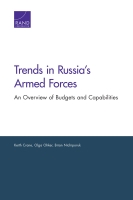by Keith Crane, Olga Oliker, Brian Nichiporuk
Research Questions
 What trends can be discerned in Russia's military budget since 2000, and what are their implications?
What trends can be discerned in Russia's military budget since 2000, and what are their implications?
What are the current and projected capabilities of Russian forces, as well as their strengths and weaknesses?
What reforms have been implemented, and what has been their effect?
The authors provide an overview of the current state of the Russian military in terms of funding and capabilities across the bulk of its forces. They describe how Russian defense budgets have increased over the course of the past 15 years, even as Russian defense spending has now entered a period of decline. They also portray a Russian military in transition, on a path to adapt its general-purpose forces to provide options more suitable to Russia's needs and intentions. They conclude that, based on the location of Russian forces and the systems that the Russian government and military have emphasized for modernization, the Russian government and military have successfully strengthened Russia's military capabilities for a distinct set of future conflict scenarios. It is important to pay close attention to Russia's modernization of its advanced air defenses and ground forces, especially its long-range fires systems — a process that has improved both its offensive and defensive capabilities. The Russian military has also improved its overall readiness level, which has resulted in an ability to quickly generate significant ground forces and to rapidly project antiair and antisea capabilities around its borders. This gives the country substantial offensive potential against bordering states, especially other former Soviet republics.
Key Findings
The Russian military has developed in three key ways since 2000
A surge in funding starting in 2000 has enabled the development of Russian military forces that are more capable under more-varied circumstances than was the case in the first two decades following the collapse of the Soviet Union.
The modernization of Russia's weapons and equipment and changes in force structure have emphasized improvements in strategic and operational air defenses focused on key defensive bastions, faster generation of ground units at high readiness, and the deployment of technologically advanced long-range battlefield fires systems. Moscow has also improved its operational-tactical missile forces, especially short-ranged ballistic missiles and land attack cruise missiles.
Growing numbers of contract soldiers, improved training, more exercises and, increasingly, combat operations in Ukraine and Syria have resulted in broad improvements in the quality of Russian units. Although most Russian forces are postured defensively, the capabilities Russia has pursued gives them substantial offensive capability against states along Russia's borders. Russia's forces also now have some limited ability to project power farther abroad, as in Syria.
Recommendations
Despite Russia's economic and military limitations, NATO policymakers and defense planners will need to continue to track and seriously monitor improvements in its military.
NATO policymakers and defense planners should also take into account Russian capabilities to invade or threaten its immediate neighbors, especially those countries not part of NATO.
No comments:
Post a Comment